
Pune, previously spelled in English as Poona, is a city in the state of Maharashtra in the Deccan plateau in Western India. It is the administrative headquarters of the Pune district, and of Pune division. According to the 2011 Census of India, Pune has 7.2 million residents in the metropolitan region, making it the seventh-most populous metropolitan area in India. The city of Pune is part of Pune Metropolitan Region. Pune is one of the largest IT hubs in India. It is also one of the most important automobile and manufacturing hubs of India. Pune is often referred to as the "Oxford of the East" because of its educational institutions. It has been ranked "the most liveable city in India" several times.

Pimpri-Chinchwad, also known as PCMC, is a city in the Indian state of Maharashtra. The city is about 15 km (9.3 mi) northwest of the historic city of Pune, at an altitude of 590 m (1,940 ft) above sea level. It is the fifth largest city in Maharashtra and the nineteenth largest city in India and the sixteenth largest satellite city in the world by population. The city is located 135 km (84 mi) southeast from the state's capital Mumbai. It is one of the most rapidly developing suburban areas in India and has emerged as the third fastest growing city in the country. It is well known for its automotive, IT and manufacturing industry.
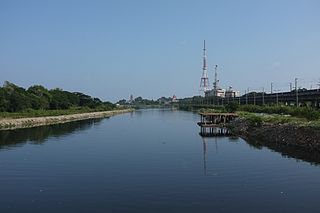
The Cooum River, or simply Koovam, is one of the shortest classified rivers draining into the Bay of Bengal. This river is about 72 km (45 mi) in length, flowing 32 km (20 mi) in the city of Chennai and the rest in rural part. The river is highly polluted in the urban area (Chennai). Along with the Adyar River running parallel to the south and the Kosasthalaiyar River, the river trifurcates the city of Chennai and separates Northern Chennai from Central Chennai. It is also sometimes known as Thiruvallikenni river
The 2005 Maharashtra floods impacted many parts of the Indian state of Maharashtra including large areas of the metropolis Mumbai, a city located on the coast of the Arabian Sea, on the Western coast of India, in which approximately 1,094 people died. It occurred just one month after the June 2005 Gujarat floods. The term 26 July, is used to refer to the day when the city of Mumbai came to a standstill due to flooding.

The MeenachilRiver or Meenachilaar, also known as Kavanar, Valanjar, is a river in Kerala. It is one of the most treacherous rivers in Kerala due to its flash floods, heavy undercurrents and woods and debris it carries from the mountains. It flows through the heart of Kottayam district, Kerala state in southern India. 78 km long, originates in the Western Ghats main tributaries are Theekoy aaru from Vagamon hills, Poonjar Aaru and Chittar, flowing westward through the city of Kottayam and other towns like Poonjar, Teekoy, Erattupetta, Bharananganam, Pala, Mutholy, Cherpunkal, Kidangoor and Kumarakom before emptying into the Vembanad Lake on the shore of the Indian Ocean.

The Mula is a river in Pune, in Maharashtra state of India. It is dammed near the Western Ghats at the Mulshi Dam that forms the Mulshi Lake. Further downstream, in Pune city, it merges with the Pawana River on the left bank and Mutha River on the right bank to form the Mula-Mutha river, which later meets the Bhima River.

Jyotisar, on the bank of Jyotisar Sarovar wetland, is a Hindu pilgrimage site in the city of Kurukshetra in Haryana state of India. According to Hindu tradition, Krishna delivered the sermon of Bhagavad Gita – the doctrine of Karma and Dharma to his wavering friend Arjuna to guide him to resolve his ethical dilemma and revealed his vishvarupa to him.

Aundh is an upscale, affluent neighbourhood in the city of Pune, India. Since its inception in the mid-1990s, Aundh has developed significantly as a residential area with proximity to the University of Pune.
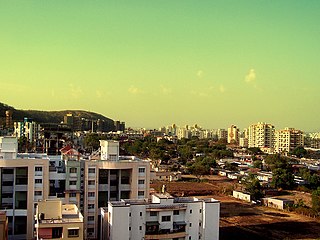
Pashan is suburb of Pune, India. It is located off the Mumbai-Bangalore national highway, by-passing Pune city. Pashan road serves as the main approach road for Mumbai-Pune expressway. Pashan is bordered by Baner in north, Sus on west, Bavdhan in south and Pune University in east. It was majorly developed by the D R Kulhalli Company. Pashan is mostly a residential suburb of Pune and large portions are occupied by various governmental and educational institutions. In October 2019, Pashan received more rainfall than the wettest place on Earth.

Pune Municipal Corporation (PMC) is the civic body that governs the inner limits of Pune, India. It is in charge of the civic needs and infrastructure of the metropolis, which is spread over an area of 500 sq. km. and has 3.4 million residents. Established on 15 February 1950, the executive power of the PMC is vested in the Municipal Commissioner, an Indian Administrative Service (IAS) officer appointed by the Government of Maharashtra. The position is held by Dr. Rajendra Bhosale, IAS.The general body of the PMC consists of 162 directly elected councilors, popularly known as "corporators", headed by a mayor. Murlidhar Mohol (BJP) was elected as the mayor and Sunita Wadekar as the deputy mayor by the newly elected in April 2021. The land for Pune Municipal Corporation was donated by Late Hon. Shri. Bhausaheb Shirole (Patil) who was second Mayor of Pune city and later became an MLC.

Pune Metro is a mass rapid transit system serving the city of Pune, India. The system comprises three lines with a combined length of 54.14 km (33.64 mi), of which 24.12 km (14.99 mi) on two lines are operational as of August 2024. The extended metro line from Ruby Hall Clinic to Ramwadi, including the Bund Garden, Kalyani Nagar and Ramwadi metro stations, covering a distance of 6 km, was inaugurated on 6 March 2024. The 16.59 km (10.31 mi) Purple Line from PCMC Bhavan to Swargate runs on an elevated viaduct between PCMC Bhavan to Range Hills, from where it goes underground. The Aqua Line runs from Vanaz to Ramwadi covering a distance of 14.66 km (9.11 mi) on an elevated viaduct. The 23.33 km (14.50 mi) elevated Line 3 Puneri Metro will run from the Rajiv Gandhi Infotech Park in Hinjawadi via Balewadi to Civil Court. All three lines will align at the District Court interchange station.
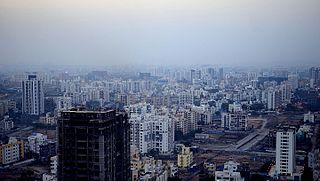
Balewadi is a residential suburban town of Pune, located in the city's Western Metropolitan Corridor. It is famous for the Shree Shiv Chhatrapati Sports Complex which had hosted both the National Games in 1994 and the 2008 Commonwealth Youth Games. The complex had also hosted the second edition of Khelo India Youth Games, which kicked off on 9 January 2019.

The Adyar River, which originates near the Chembarambakkam Lake in the Kanchipuram district, is one of the three rivers that winds through Chennai, Tamil Nadu, India, and joins the Bay of Bengal at the Adyar estuary. The 42.5-kilometre (26.4 mi) long river contributes to the estuarine ecosystem of Chennai. Despite the high pollution levels, boating and fishing take place in this river. The river collects surplus water from about 200 tanks and lakes, small streams and the rainwater drains in the city, with a combined catchment area of 860 square kilometres (331 sq mi). Most of the waste from the city is drained into this river and the Cooum.

Baner is a suburb in the Western Metropolitan Corridor of Pune, India. Baner is well known for "Varkari" Parampara and Bhakti Aradhana from many years. Baner is bordered by Pashan in south, Balewadi to the west, Aundh to the north and Pune University to the east.

The Baner-Pashan Biodiversity Park is a proposed 200 hectare protected region currently under development in the Baner and Pashan suburbs of Pune, India by the Pune Municipal Corporation. The park is being constructed to protect the biodiversity near and around the Baner Hill and its spur, the Pashan Hill.
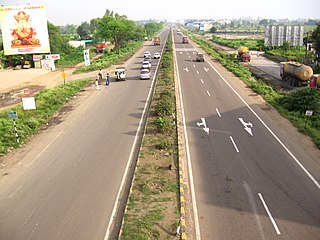
Wakad is a neighbourhood in the city of Pimpri-Chinchwad, India. Given its close proximity to Rajiv Gandhi Infotech Park in Hinjawadi, Wakad has recently emerged to be a popular neighbourhood for techies and expats. It is very diverse and cosmopolitan.
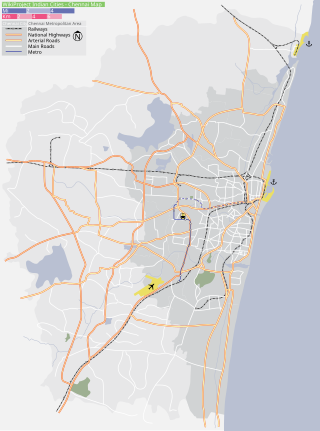
Pallavaram Lake, also known as Periya aeri or Pallavaram aeri, is situated along Pallavaram Thuraipakkam Radial Road. It used to be a large lake, but it dried up and was polluted by industrial wastewater and garbage.

Pashan Lake is an artificial lake near the suburb of Pashan, about 12 km from the city center of Pune, India. The lake was built in the British era to accommodate the water requirement of the neighbourhood. The main inlet of the lake is the Ramnadi river, which is even controlled by a barrage located to the north of the lake. The river originates from Bavdhan and flows via Pashan, Sutarwadi, Baner to Someshwarwadi before flowing into the main Mula river. Pashan lake has a total catchment area of 40 square kilometres (15 sq mi), and serves as a source of water to the old Pashan village, and the governor's residence, as well. Recent urbanisation around the lake has led to the fall in the quality of the water.
Suvarna Sahakari Bank was an Indian private urban co-operative bank based in Pune, Maharashtra, India, which operated from its incorporation on 22 September 1969 till its dissolution on 20 May 2009.
Neknampur Lake, also known as Ibrahim Bagh Cheruvu, located in Indian city of Hyderabad, was once part of a water reservoir network that was used for irrigation and providing drinking in the surrounding areas.



















